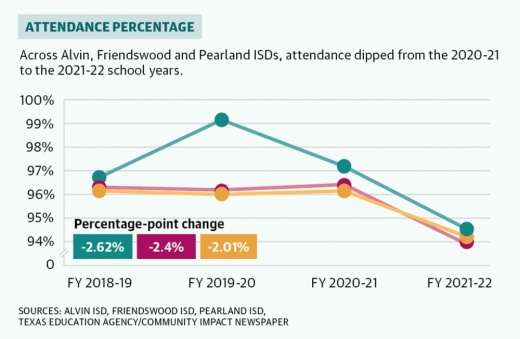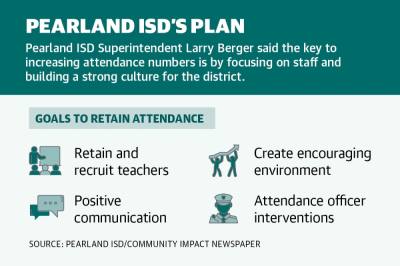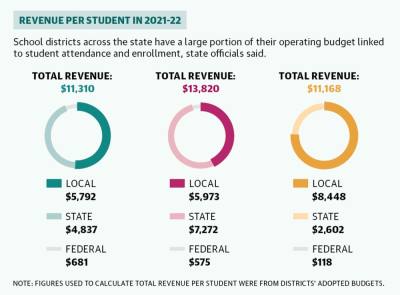As enrollment declines, Pearland ISD and districts across the state aim to increase the percentage of students who show up to class by focusing on teacher retention and other strategies.
The Texas Education Agency has seen declining enrollment and attendance rates across school districts since the beginning of the COVID-19 pandemic, according to TEA officials, in a written statement provided in an email.
Overall student enrollment and attendance numbers—the frequency at which enrolled students attend classes—are crucial for Texas districts because they determine districts’ funding from state and local sources, TEA and district officials said.
While PISD is not alone in decreasing enrollment numbers, most of the land within its boundary has already been developed, which limits the number of new students who can move to the area, PISD Superintendent Larry Berger told Community Impact Newspaper in April. This makes increasing attendance a priority, he said.
“The city of Pearland is kind of built out,” Berger said. “We are infielding. We are not like Alvin where we have all this space where we can keep building these great housing communities. We already have our great housing. We have to maximize the students that are there.”
PISD plans to do this by focusing on teacher retention, recruitment and creating an encouraging environment, Berger said.
“We are communicating at the start of the school year the importance of daily attendance,” he said.
Enrollment figures
Over the last 10 years starting with the 2013-14 school year, PISD’s enrollment has hovered between 20,000-22,000 students.
Since the 2019-20 school year, however, PISD’s enrollment has decreased each year. Enrollment for the 2022-23 school year is projected to be 20,730 students, the lowest since the 2014-15 school year, according to TEA and district data.
In comparison, Alvin ISD projects enrollment for 2022-23 will be 29,270 students—a 47.76% increase from its 2013-14 enrollment, according to TEA data. At Friendswood ISD, enrollment has lingered around 6,000-6,300 students over the last decade. While FISD saw an enrollment dip from 2019-20 to 2020-21, FISD expects its 2022-23 enrollment to be 6,298 students, which would be its highest enrollment in the past 10 years.
“While we have a plateaued enrollment, we [also] had a decrease in attendance,” Berger said. “We need to make sure that we push our students and we push our parents. We need you to come to school so you can be successful and we can educate you.”
At all three districts, and across the state, there has been a decreasing trend in overall attendance and enrollment, according to the TEA data. All three districts’ average daily attendance percentage fell between 2019-20 and 2021-22.
FISD’s attendance percentage decreased from 96.19% to 94.18% between the 2020-21 and 2021-22 school years. Similarly, AISD’s attendance percentage went from 96.39% to 93.99% in the same time. PISD followed the same trend, falling from 97.17% in 2020-21 to 94.55% for the 2021-22 school year.
“Approximately 90% of a school district’s operating budget is linked to student attendance,” the TEA said in the statement.
Behind the attendance dips
Education officials said various factors have affected school districts’ attendance. Both AISD Superintendent Carol Nelson and Berger credited the pandemic as a contributing factor in the attendance dips.
“During the 2020-21 school year, we had the option of virtual learning, so even if a student was out sick or in quarantine, we had the option of offering virtual learning, which allowed us to count them in our attendance numbers,” Nelson said.
Joan Pedro, dean of the college of education at the University of Houston-Clear Lake, also said the pandemic has affected enrollment and attendance across school districts in Texas.
When the pandemic first surged in March 2020, school districts across the state offered remote learning, and many students were able to continue attending classes virtually, an option not available for most districts in 2021-22, Pedro said. Conversely, she also attributed the ongoing statewide teacher shortage as another factor.
“In addition to surging COVID-19 cases at the end of 2021, schools have faced severe staff shortages, high rates of absenteeism, quarantines and rolling school closures,” she said.
The consequences of students missing out on instruction days go beyond just financial woes for school districts. Pedro said the biggest effect of decreasing attendance is the loss of instructional time for students.
“Research indicates that the impact of the pandemic on K-12 student learning was significant, leaving students on average five months behind in mathematics and four months behind in reading by the end of the school year,” Pedro said.
To correct the negative effects caused by disrupted attendance across the state, Pedro said districts, colleges and universities need to be proactive on an issue.
School districts, colleges and universities are collaborating to fill the vacancies that have risen from public school teacher and administrator resignations and retirements, Pedro said. Examples include creating alternative certification programs to help teachers get prepared and meet school district staffing needs, she said.
“Districts have been putting structures and processes in place to bridge the gap of vacancies by employing more teachers and making use of paraprofessionals,” Pedro said.
Increasing attendance
As the 2022-23 school year nears, school districts will look to increase their attendance percentage numbers. Attendance largely determines state and local funding, the TEA said.
An example is with average daily attendance, which reflects how often a district’s enrolled students go to school, Berger said. Average attendance plays a huge factor in how much funding a district gets per student, the TEA said.
For the 2020-21 school year, PISD had roughly $12,000 in revenue for each student, according to district data. According to PISD’s 2022-23 budget documents, the district’s 2021-22 amended budget total revenue fell to roughly $11,310 per student. During that same window, PISD saw its attendance drop by 2.62 percentage points between the 2020-21 and 2021-22 year.
“Our district loses money when a student is absent,” Berger said. “At the same time, we budget and still pay for teacher and staff salaries, operations, building maintenance, electricity and all the other expenses involved with running the district.”
Berger said he wishes the state used an enrollment funding model, which can include single-day count or counts from multiple days to determine how much funding a district gets instead of average daily attendance, which factors attendance every instructional day of the school year.
In the meantime, PISD will focus on using data and communication to retain students, Berger said. PISD plans to emphasize at the start of the school year the importance of daily attendance to students and during the school year will use attendance officer interventions when needed to help maintain high daily attendance, Berger said.
“We have just received the commissioned 10-year student population projections and are reviewing them along with any city development projections,” Berger said. “The data will help us identify future mobility and housing trends. This data coupled with data from surrounding districts will enable the development of a targeted plan for student retention.”
Additionally, by focusing on teacher retention, the district will increase attendance numbers for students because PISD will be able to provide high-quality education and programs that in turn help recruit and retain students, Berger said.
In April, PISD approved a 2% raise for teachers, auxiliary staff, and administrative and professional staff. Additionally, the district raised the teacher starting pay to $59,600 for 2022-23, a rise from $59,000 in 2021-22.
“By securing and sustaining the highest-quality instructional and support staff, we can provide the highest-quality education and programs to recruit and retain students,” Berger said.








